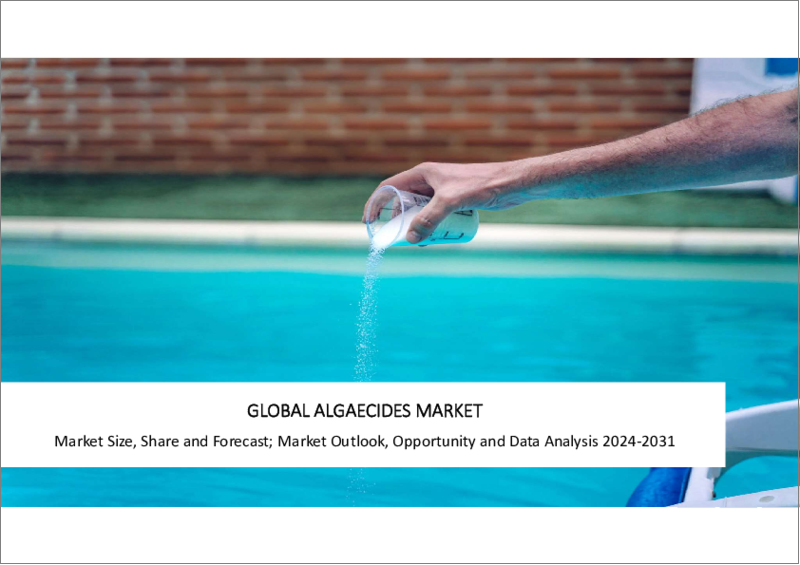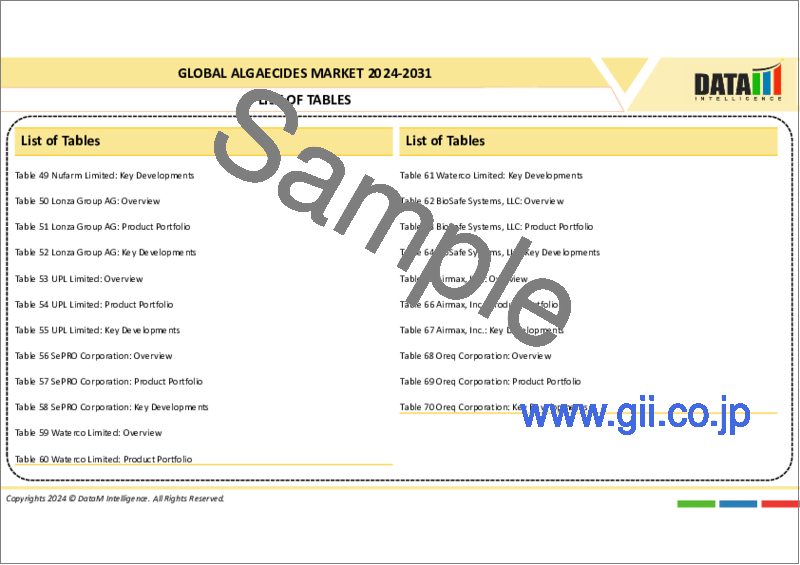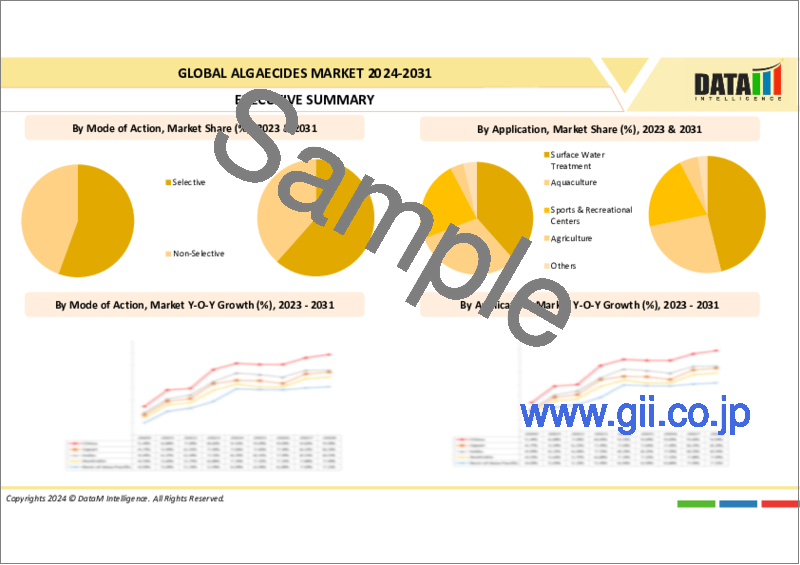|
|
市場調査レポート
商品コード
1268906
殺藻剤の世界市場-2023-2030Global Algaecides Market - 2023-2030 |
||||||
カスタマイズ可能
適宜更新あり
|
|||||||
| 殺藻剤の世界市場-2023-2030 |
|
出版日: 2023年05月02日
発行: DataM Intelligence
ページ情報: 英文 195 Pages
納期: 即日から翌営業日
|
- 全表示
- 概要
- 目次
市場概要
世界の殺藻剤市場は、予測期間(2023-2030)中に7.2%のCAGRで成長する見通しです。
藻類やシアノバクテリアは殺藻剤によって死滅させられ、その成長を止めるためにも使用されます。殺藻剤には、天然と合成の2種類があります。これらは通常、浮遊性藻類、分岐性藻類、糸状藻類を防ぐために採用されます。殺藻剤の効果は、製品の処方、水質、散布量など、さまざまな変数に影響されます。植物プランクトンを殺すだけでなく、大発生を阻止したり、規模を縮小したりするためにも使用されます。液体、粒状、パレットなど、さまざまな形態で提供されます。
市場力学
環境・生態系を守ることへの関心と意識の高まり
藻の発生がもたらす悪影響に対する消費者の意識の高まりが、殺藻剤の使用を促しています。藻類は、人間と海洋の両方の健康に悪影響を及ぼします。多くの政府機関や企業は、藻類の繁殖を防止または阻止するために、殺藻剤に対する消費者の意識を高めることに注力しています。このように、環境や生態系の保護に対する人々の関心や意識が高まるにつれて、市場は拡大しています。
様々な最終用途における殺藻剤の需要の高まり
養殖や表流水処理では、殺藻剤が多用されています。藻類の成長を止め、養殖や表面水処理の効果的な運用を支援するために、多くの企業やメーカーが殺藻剤を提供しています。市場は、養殖や表面水処理のような多くの最終用途産業における殺藻剤の需要の増加により拡大しています。例えば、米国の養殖業界では、海洋二枚貝(アサリ、カキ、ホタテ)の全段階、一部の海洋腹足類(アワビ、巻貝)の幼生段階、いくつかの海洋魚種の幼生、ペナイエビ、動物プランクトンが、餌として微細藻類に依存していると主張しています。
COVID-19影響分析
COVID-19の分析には、Pre-COVIDシナリオ、COVIDシナリオ、Post-COVIDシナリオがあり、価格ダイナミクス(パンデミック時およびパンデミック後の価格変動とCOVID前のシナリオとの比較)、需要-供給スペクトラム(取引制限、ロックダウンおよびその後の問題による需要と供給のシフト)、政府の取り組み(政府機関による市場、セクター、産業の活性化に関する取り組み)、メーカーの戦略的取り組み(COVID問題を軽減するためのメーカーの取り組み)についても解説する予定です。
目次
第1章 調査手法とスコープ
- 調査手法
- 調査目的および調査範囲について
第2章 定義と概要
第3章 エグゼクティブサマリー
- タイプ別スニペット
- フォーム別スニペット
- 作用機序別スニペット
- アプリケーション別スニペット
- 地域別スニペット
第4章 市場力学
- 影響要因
- 促進要因
- 抑制要因
- 機会
- 影響度分析
第5章 産業分析
- ポーターのファイブフォース分析
- サプライチェーン分析
- 価格分析
- 規制分析
第6章 COVID-19の分析
- COVID-19の解析について
- COVID-19シナリオ前
- 現在のCOVID-19シナリオ
- ポストCOVID-19または将来シナリオ
- COVID-19 の中での価格ダイナミクス
- 需給スペクトル
- パンデミック時の市場に関連する政府の取り組み
- メーカーの戦略的な取り組み
- 結論
第7章 タイプ別
- キレート銅
- 第4級アンモニウム化合物
- キレート銅
- ペルオキシ酢酸・二酸化水素
- 染料・着色料
- その他
第8章 フォーム別
- 液体
- 乾燥
第9章 作用機序別
- 選択
- 非選択
第10章 アプリケーション別
- 表流水処理
- 水産
- スポーツ・レクリエーションセンター
- 農業
- その他
第11章 地域別
- 北米
- 米国
- カナダ
- メキシコ
- 欧州
- ドイツ
- 英国
- フランス
- イタリア
- スペイン
- その他欧州
- 南米
- ブラジル
- アルゼンチン
- その他南米地域
- アジア太平洋地域
- 中国
- インド
- 日本
- オーストラリア
- その他アジア太平洋地域
- 中東・アフリカ地域
第12章 競合情勢
- 競合シナリオ
- 市況分析・シェア分析
- M&A分析
第13章 企業プロファイル
- BASF SE
- 会社概要
- 製品ポートフォリオと説明
- 財務概要
- 主な展開
- Dow
- Nufarm Limited
- Lonza Group AG
- UPL Limited
- SePRO Corporation
- Waterco Limited
- BioSafe Systems, LLC
- Airmax, Inc.
- Oreq Corporation.
第14章 付録
Market Overview
The global algaecides market reached US$ XX million in 2022 and is projected to witness lucrative growth by reaching up to US$ XX million by 2030. The market is growing at a CAGR of 7.2% during the forecast period (2023-2030).
Algae or cyanobacteria are killed by algaecide, which is also used to stop their growth. There are two different kinds of algaecides, natural and synthetic. They are typically employed to prevent planktonic, branched, and filamentous algae. Algaecide effectiveness is influenced by a number of variables, including product formulation, water chemistry, and application amounts. In addition to killing phytoplankton, it is also used to stop or scale back large blooms. It comes in a variety of forms, including liquid, granular, and pallets. Surface waters are injected with it or sprayed with it.
Market Dynamics
Increasing concern and awareness about protecting the environment and ecosystem
Growing consumer awareness of the negative effects of algae formation encourages the use of algaecides. Algae have a negative impact on both human and marine health. Many governmental organizations and businesses are concentrating on raising consumer awareness of algaecides in order to prevent or stop the growth of algae. Thus, the market expands as people's concerns and awareness about protecting the environment and ecosystem grow.
The rising demand for algaecides across a range of end uses
Aquaculture and surface water treatment both make extensive use of algaecides. To stop the growth of algae and aid in the effective operation of aquaculture and surface water treatment, many businesses and manufacturers offer algaecides. The market is expanding due to the increasing demand for algaecides in numerous end-use industries like aquaculture and surface water treatment. For instance, the U.S. aquaculture industry claims that all stages of marine bivalve molluscs (clams, oysters, and scallops), the larval stages of some marine gastropods (abalone, conch), larvae of several marine fish species, penaeid shrimp, and zooplankton depend on micro-algae as a food source.
COVID-19 Impact Analysis
The COVID-19 analysis includes Pre-COVID Scenario, COVID Scenario and Post-COVID Scenario along with pricing dynamics (including pricing change during and post-pandemic comparing it with pre-COVID scenarios), demand-supply spectrum (shift in demand and supply owing to trading restrictions, lockdown and subsequent issues), government initiatives (initiatives to revive market, sector or industry by government bodies) and manufacturers strategic initiatives (what manufacturers did to mitigate the COVID issues will be covered here).
Segment Analysis
The global algaecides market is segmented based on type, form, mode of action, application and region.
The chelated copper segment holds a significant market share in the global algaecides market
The chelated copper segment accounted for the largest share due to the rise in consumer preference towards copper compounds in order to treat a larger range of algae species. An algaecide, which frequently makes use of copper sulfate or chelated copper, is essentially just a substance that can kill or reduce algae. As it attaches to the pond's algae and blocks photosynthesis, copper is effective at killing algae. One of the best remedies for treating algae problems in ponds and lakes is copper algaecide when used properly. They have a number of other copper algaecides besides Captain that can get rid of algae, which results in lucrative sales in the segment.
Geographical Analysis
North America holds the highest share in the global algaecides market
The algaecides market in the U.S. is booming. Algaecides are being used largely by the thriving agriculture sector to protect high-quality crops and address algae-related problems. The presence of a wide network of water bodies including lakes, rivers, and reservoirs in the country has also contributed to increasing demand for algaecides as a strategy to increase water quality and preserve both water conservation and public health. The demand for algaecides is also growing as more people participate in water-based activities. The rising middle class in the U.S. is driving the rise of these activities, and algaecides serve a critical role in providing high-quality water and minimizing algae-related concerns.
On the other hand, Asia-Pacific is the fastest-growing region in the world. The market for algaecides in China is expanding quickly, and a number of factors make it a desirable location for market participants. The emphasis on water conservation in China is one of the main factors influencing algaecides sales.
Competitive Landscape
The major global players in the market include: BASF SE, Dow, Nufarm Limited, Lonza Group AG, UPL Limited, SePRO Corporation, Waterco Limited, BioSafe Systems, LLC, Airmax, Inc., and Oreq Corporation among others.
Why Purchase the Report?
- To visualize the global algaecides market segmentation based on type, form, mode of action, application and region, as well as understand key commercial assets and players.
- Identify commercial opportunities by analyzing trends and co-development.
- Excel data sheet with numerous data points of algaecides market-level with all segments.
- PDF report consists of a comprehensive analysis after exhaustive qualitative interviews and an in-depth study.
- Product mapping available as Excel consisting of key products of all the major players.
The global algaecides market report would provide approximately 53 tables, 54 figures and 195 pages.
Target Audience 2023
- Manufacturers/ Buyers
- Industry Investors/Investment Bankers
- Emerging Companies
Table of Contents
1. Methodology and Scope
- 1.1. Research Methodology
- 1.2. Research Objective and Scope of the Report
2. Definition and Overview
3. Executive Summary
- 3.1. Snippet by Type
- 3.2. Snippet by Form
- 3.3. Snippet by Mode of action
- 3.4. Snippet by Application
- 3.5. Snippet by Region
4. Dynamics
- 4.1. Impacting Factors
- 4.1.1. Drivers
- 4.1.2. Restraints
- 4.1.3. Opportunity
- 4.1.4. Impact Analysis
5. Industry Analysis
- 5.1. Porter's Five Forces Analysis
- 5.2. Supply Chain Analysis
- 5.3. Pricing Analysis
- 5.4. Regulatory Analysis
6. COVID-19 Analysis
- 6.1. Analysis of COVID-19
- 6.1.1. Before COVID-19 Scenario
- 6.1.2. Present COVID-19 Scenario
- 6.1.3. Post COVID-19 or Future Scenario
- 6.2. Pricing Dynamics Amid COVID-19
- 6.3. Demand-Supply Spectrum
- 6.4. Government Initiatives Related to the Market During Pandemic
- 6.5. Manufacturers Strategic Initiatives
- 6.6. Conclusion
7. By Type
- 7.1. Introduction
- 7.1.1. Market Size Analysis and Y-o-Y Growth Analysis (%), By Type
- 7.1.2. Market Attractiveness Index, By Type
- 7.2. Chelated Copper *
- 7.2.1. Introduction
- 7.2.2. Market Size Analysis and Y-o-Y Growth Analysis (%)
- 7.3. Quaternary Ammonium Compounds
- 7.4. Chelated Copper
- 7.5. Peroxyacetic Acid & Hydrogen Dioxide
- 7.6. Dyes & Colorants
- 7.7. Others
8. By Form
- 8.1. Introduction
- 8.1.1. Market Size Analysis and Y-o-Y Growth Analysis (%), By Form
- 8.1.2. Market Attractiveness Index, By Form
- 8.2. Liquid *
- 8.2.1. Introduction
- 8.2.2. Market Size Analysis and Y-o-Y Growth Analysis (%)
- 8.3. Dry
9. By Mode of Action
- 9.1. Introduction
- 9.1.1. Market Size Analysis and Y-o-Y Growth Analysis (%), By Mode of Action
- 9.1.2. Market Attractiveness Index, By Mode of Action
- 9.2. Selective *
- 9.2.1. Introduction
- 9.2.2. Market Size Analysis and Y-o-Y Growth Analysis (%)
- 9.3. Non-Selective
10. By Application
- 10.1. Introduction
- 10.1.1. Market Size Analysis and Y-o-Y Growth Analysis (%), By Application
- 10.1.2. Market Attractiveness Index, By Application
- 10.2. Surface Water Treatment *
- 10.2.1. Introduction
- 10.2.2. Market Size Analysis and Y-o-Y Growth Analysis (%)
- 10.3. Aquaculture
- 10.4. Sports & Recreational Centers
- 10.5. Agriculture
- 10.6. Others
11. By Region
- 11.1. Introduction
- 11.1.1. Market Size Analysis and Y-o-Y Growth Analysis (%), By Region
- 11.1.2. Market Attractiveness Index, By Region
- 11.2. North America
- 11.2.1. Introduction
- 11.2.2. Key Region-Specific Dynamics
- 11.2.3. Market Size Analysis and Y-o-Y Growth Analysis (%), By Type
- 11.2.4. Market Size Analysis and Y-o-Y Growth Analysis (%), By Form
- 11.2.5. Market Size Analysis and Y-o-Y Growth Analysis (%), By Mode of action
- 11.2.6. Market Size Analysis and Y-o-Y Growth Analysis (%), By Application
- 11.2.7. Market Size Analysis and Y-o-Y Growth Analysis (%), By Country
- 11.2.7.1. The U.S.
- 11.2.7.2. Canada
- 11.2.7.3. Mexico
- 11.3. Europe
- 11.3.1. Introduction
- 11.3.2. Key Region-Specific Dynamics
- 11.3.3. Market Size Analysis and Y-o-Y Growth Analysis (%), By Type
- 11.3.4. Market Size Analysis and Y-o-Y Growth Analysis (%), By Form
- 11.3.5. Market Size Analysis and Y-o-Y Growth Analysis (%), By Mode of action
- 11.3.6. Market Size Analysis and Y-o-Y Growth Analysis (%), By Application
- 11.3.7. Market Size Analysis and Y-o-Y Growth Analysis (%), By Country
- 11.3.7.1. Germany
- 11.3.7.2. The U.K.
- 11.3.7.3. France
- 11.3.7.4. Italy
- 11.3.7.5. Spain
- 11.3.7.6. Rest of Europe
- 11.4. South America
- 11.4.1. Introduction
- 11.4.2. Key Region-Specific Dynamics
- 11.4.3. Market Size Analysis and Y-o-Y Growth Analysis (%), By Type
- 11.4.4. Market Size Analysis and Y-o-Y Growth Analysis (%), By Form
- 11.4.5. Market Size Analysis and Y-o-Y Growth Analysis (%), By Mode of action
- 11.4.6. Market Size Analysis and Y-o-Y Growth Analysis (%), By Application
- 11.4.7. Market Size Analysis and Y-o-Y Growth Analysis (%), By Country
- 11.4.7.1. Brazil
- 11.4.7.2. Argentina
- 11.4.7.3. Rest of South America
- 11.5. Asia-Pacific
- 11.5.1. Introduction
- 11.5.2. Key Region-Specific Dynamics
- 11.5.3. Market Size Analysis and Y-o-Y Growth Analysis (%), By Type
- 11.5.4. Market Size Analysis and Y-o-Y Growth Analysis (%), By Form
- 11.5.5. Market Size Analysis and Y-o-Y Growth Analysis (%), By Mode of action
- 11.5.6. Market Size Analysis and Y-o-Y Growth Analysis (%), By Application
- 11.5.7. Market Size Analysis and Y-o-Y Growth Analysis (%), By Country
- 11.5.7.1. China
- 11.5.7.2. India
- 11.5.7.3. Japan
- 11.5.7.4. Australia
- 11.5.7.5. Rest of Asia-Pacific
- 11.6. Middle East and Africa
- 11.6.1. Introduction
- 11.6.2. Key Region-Specific Dynamics
- 11.6.3. Market Size Analysis and Y-o-Y Growth Analysis (%), By Type
- 11.6.4. Market Size Analysis and Y-o-Y Growth Analysis (%), By Form
- 11.6.5. Market Size Analysis and Y-o-Y Growth Analysis (%), By Mode of action
- 11.6.6. Market Size Analysis and Y-o-Y Growth Analysis (%), By Application
12. Competitive Landscape
- 12.1. Competitive Scenario
- 12.2. Market Positioning/Share Analysis
- 12.3. Mergers and Acquisitions Analysis
13. Company Profiles
- 13.1. BASF SE*
- 13.1.1. Company Overview
- 13.1.2. Product Portfolio and Description
- 13.1.3. Financial Overview
- 13.1.4. Key Developments
- 13.2. Dow
- 13.3. Nufarm Limited
- 13.4. Lonza Group AG
- 13.5. UPL Limited
- 13.6. SePRO Corporation
- 13.7. Waterco Limited
- 13.8. BioSafe Systems, LLC
- 13.9. Airmax, Inc.
- 13.10. Oreq Corporation.
LIST NOT EXHAUSTIVE
14. Appendix
- 14.1. About Us and Services
- 14.2. Contact Us





